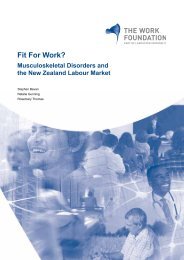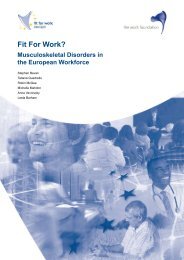FfW Bulgarian report (English language) - Fit for Work Europe
FfW Bulgarian report (English language) - Fit for Work Europe
FfW Bulgarian report (English language) - Fit for Work Europe
You also want an ePaper? Increase the reach of your titles
YUMPU automatically turns print PDFs into web optimized ePapers that Google loves.
4.3<br />
Conditionspecific<br />
interventions<br />
Interventions<br />
It seems that the reasons behind the burden of disability on the <strong>Bulgarian</strong> society are twofold.<br />
First, unhealthy lifestyle factors, lack of timely treatment of illness and prevention of<br />
disability determine the large number of working age people who become disabled and rely<br />
on the welfare benefits. On the other hand, the rigid system of disability assessment, focused<br />
on incapacity, as well as lack of opportunities to seek employment while not 100 per cent fit,<br />
discourages many people from remaining active at the labour market.<br />
A focus on rehabilitation services will increase social inclusion of disabled people, as well as<br />
maintain pool of skilled workers participating in the labour market (NSSI, 2010). Yet, disabled<br />
employees in Bulgaria rarely have access to individual support on the job that would take into<br />
consideration their personal needs. It is important that people with limited abilities are better<br />
integrated into society and the labour market in particular. Developing a system of disability<br />
assessment that evaluates the ability of individuals to work not just their affected capability, has<br />
to become a priority both at the state and organisational level.<br />
For those with specific musculoskeletal conditions, speedy referral to the appropriate<br />
specialist <strong>for</strong> investigation and treatment is usually vital. Those with MSDs can experience<br />
numerous problems associated with long term care, including long waits, failure to undertake<br />
a multidisciplinary approach, poor advice on pain management, and a lack of clear integrated<br />
pathways. Notwithstanding this, there are a number of condition-specific interventions which<br />
have been shown to be effective in improving job retention and return to work.<br />
4.3.1 Non-specific MSDs<br />
The primary focus of this <strong>report</strong> has been to examine the interventions and other factors which<br />
affect job retention, labour market participation and job quality among those with MSDs. As we<br />
have seen, there is evidence that physical impairment can represent a barrier to each of these<br />
aspects, but that many people – even those with serious and chronic incapacity – can and do<br />
lead full and fulfilling working lives. Since back pain and the majority of work-related upper limb<br />
disorders are not diseases to be cured, and there is very limited evidence that prevention is<br />
possible, it has been argued that the focus of treatment should be on returning to the highest<br />
or desired level of activity and participation, and the prevention of chronic complaints and<br />
recurrences (Burton, 2005; Bekkering et al., 2003) rather than eradicating the cause of the<br />
problem or returning to normal function.<br />
Whilst treatment to ease or relieve the symptoms of non-specific MSDs will always be a<br />
priority, medical intervention is not necessarily the only, or the best route to recovery or helping<br />
those with non-specific MSDs to manage their condition. In fact, <strong>for</strong> non-specific conditions,<br />
an individual’s recovery and chances of returning to work can be adversely affected by ‘over-<br />
<strong>Fit</strong> For <strong>Work</strong>? 49







